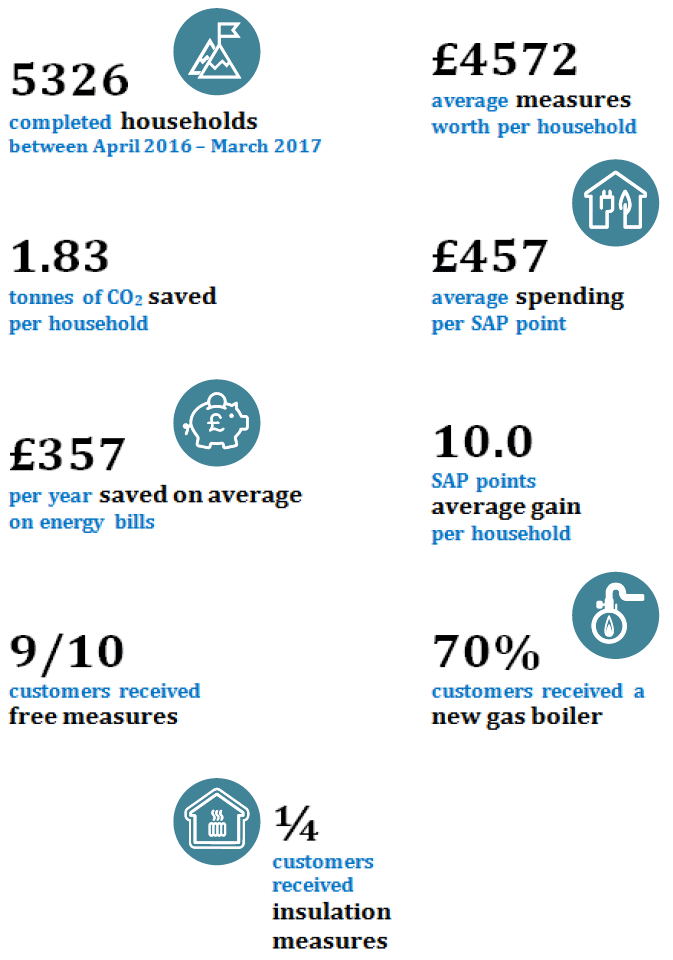Home Energy Efficiency Programmes Scotland: annual review 2016-2017
A review of how the Warmer Homes Scotland Scheme has performed and made progress towards meeting the scheme's stated objectives.
Part 3: Objective 2 - Climate Change
The second stated objective of Warmer Homes Scotland is to contribute to a reduction in the emissions of carbon dioxide from Scottish homes.
It is widely accepted that the most cost effective way to reduce emissions, and therefore tackle climate change, is by reducing demand for energy. Warmer Homes Scotland was designed to help address the issue of energy demand amongst fuel poor households. The scheme emphasises a “fabric first” approach to measures installation and imposes restrictions on support for certain high carbon fuel types such as oil central heating.
To determine the extent to which Warmer Homes Scotland is contributing to the reduction in domestic energy demand, and therefore meeting its climate change objective, this review sought to answer the following questions:
- Is Warmer Homes Scotland contributing to a reduction in greenhouse gas emissions?
- Does Warmer Homes Scotland offer the most suitable measures to respond to climate change challenges?
At the time of the 2015/16 Annual Review the carbon and fuel bill savings reporting structure was not in place and the evidence assessed was based on modelled data. For the 2016/17 Annual Review modelled data based on more accurate data is available and used for this comparison. Table 5 shows the breakdown of the total number of measures installed in 2016/17, and from this, Figure 11 demonstrates the key findings and includes the full list of all measures available through Warmer Homes Scotland.
The data indicates that, on average, a higher level of financial investment has been made per household in 2016/17, £4572 in 2016/17 versus £4000 in 2015-16. This has delivered an average increase in fuel bill savings of £7; increasing to £357 in 2016/17 from £350 in 2015-16. The average SAP point gain per property achieved in 2016/17 is 10.0 compared to 14.9 in 2015-16 and the average annual carbon emissions saved per household in 2016/17 was 1.83 tonnes compared to 2.41 tonnes in 2015-16.
The data available for 2015/16 covered a 7 month winter period during which the number of installations of measures such as External Wall Insulation falls dramatically, therefore, it is impossible to make a meaningful comparison. This should be carried out in the 2017/18 Annual Review when a full data set is available.
A more in-depth analysis of the data is also required to establish the associated investment and carbon emissions savings or SAP point gains per recipient household. For example, it may be the case that there has been an increased level of support provided to rural, island, off-gas grid, stone-built or EPC Band D properties, any of which may incur higher costs per measure installed. However, it is reasonable to suggest that as increasing numbers of “easy to treat” properties benefit from the installation of measures under Warmer Homes Scotland, the financial cost to improve the energy efficiency rating of the remaining properties inhabited by fuel poor households will increase. This would have a knock on effect on the associated Climate Change gains from Warmer Homes Scotland.
The available data indicates that Warmer Homes Scotland is having a positive impact on customers’ energy demand levels and associated energy-based financial outgoings. In total, during 2016/17 the scheme delivered 9670 tonnes in CO 2 savings and this directly contributed to the Scottish Government’s ambitious emissions reduction targets.
Table 5: Breakdown of measures installed in 2016/17
| Measure | Quantity |
|---|---|
| Air Source Heat Pump | 32 |
| Biomass Boiler | 3 |
| Biomass Boiler - Back Boiler | 0 |
| Boiler Renewable Heat Source Repair | 7 |
| Building Fabric Electrical | 0 |
| Cavity Wall Insulation | 170 |
| Central Heat Pipe Enclosure | 301 |
| CO Detector | 4663 |
| District Heating | 0 |
| Draught Proofing | 250 |
| Electric Load Upgrade | 125 |
| Electric Storage Heaters | 242 |
| Energy Efficient glazing/doors | 558 |
| External Wall Insulation | 164 |
| Flat Roof Insulation | 23 |
| Flexible Thermal Linings | 0 |
| Floor Insulation | 84 |
| Flue Gas Recovery Device | 57 |
| Gas Boiler LPG | 281 |
| Gas Connection | 574 |
| Gas Fired Condensing Boilers | 3770 |
| Heating Hot Water and AC Controls Hot Water Systems | 4010 |
| Heating Secondary Systems | 3542 |
| Heating System Insulation | 3547 |
| Hot Water Systems | 236 |
| Hybrid Wall Insulation | 2 |
| Internal Wall Insulation | 68 |
| Lighting Fittings | 0 |
| Loft Insulation | 703 |
| LPG Detector Monitor | 249 |
| Mechanical Ventilation | 0 |
| Micro Combined Heat and Power | 0 |
| Micro Hydro Systems | 0 |
| Oil Fired Condensing Boilers | 468 |
| Pitched Roof Insulation | 26 |
| Secondary Pipework Radiators and TRV Repairs | 344 |
| Smoke Alarm | 5257 |
| Solar Blinds Shutters and Shades | 0 |
| Solar PV | 3 |
| Solar Thermal | 1 |
| Under Floor Heating | 0 |
| Variable Speed Pump and Fan Drives | 23 |
| Warm Air Heating Systems | 0 |
| Water Efficient Taps | 0 |
| Wind Turbines | 0 |
| Total | 29816 |
Figure 11: Climate change related findings

Contact
There is a problem
Thanks for your feedback